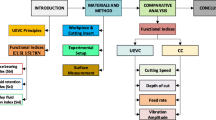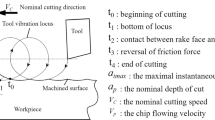Abstract
The application of micro-textured cutting tools in various machining operations has been widely recommended as an efficient method for improving cutting performance. However, the realm of micro-textured tool utilization is rarely found in nonconventional cutting processes. This paper investigates the performance capability of a rake-faced micro-textured tool in ultrasonic elliptical vibration cutting (UEVC), which is a typical nonconventional cutting technique. A comparative experimental turning of 304 stainless steel with the micro-textured tool was performed under UEVC and conventional cutting (CC) while employing variable cutting parameters as governing factors. The cutting performance of the micro-textured tool was measured in terms of cutting forces, surface topography, chip morphology, and wear mechanism. The experimental findings revealed that the micro-textured tool outperformed the non-textured tool (NTT) in the overall machining-related outputs and the combined effect of utilizing the UEVC mechanism and cutting tool texturing techniques can significantly enhance the remarkable machining benefits of UEVC.


















Similar content being viewed by others
Data availability
All data used in the manuscript are available as submitted.
Code availability
Not applicable.
References
Astakhov VP (2007) Editorial: tribology at the forefront of study and research on metal cutting. Int J Machin Machinabil Mater 2(3):309–315. https://doi.org/10.1504/IJMMM.2007.015490
Astakhov VP (2006) Tribology of metal cutting. Elsevier, London
Yingshuai X, Zhihui W, Ping Z, Weili H, Guoqing Z (2020) Experimental study on cutting force in theultrasonic vibration-assisted turning of 304 austenitic stainless. Proc IMechE Part B: J Engineering Manufacture. https://doi.org/10.1177/0954405420957127
Zhang X, Kumar AS, Rahman M, Nath C, Liu K (2011) Experimental study on ultrasonic elliptical vibration cutting of hardened steel using PCD tools. J Mater Process Technol 211(11):1701–1709. https://doi.org/10.1016/j.jmatprotec.2011.05
Kramer BM (1993) Tribological aspects of metal cutting ASME Journal of Engineering for Industry 115:372–376. https://doi.org/10.1115/1.2901677
Olortegui-Yume JA, Kwon PY (2007) Tool wear mechanisms in machining Int. J Machining and Machinability of Mater 2(3):316–334
Priya R, Somashekhar SH (2019) Role of textured tool in improving machining performance: a review. J Manuf Proc 43:47–73. https://doi.org/10.1016/j.jmapro.2019.04.011
Weinert K, Inasaki I, Sutherland JW, Wakabayashi T (2004) Dry machining and minimum quantity lubrication. CIRP Ann - Manuf Technol 53:511–537. https://doi.org/10.1016/S0007-8506(07)60027-4
Shokrani A, Dhokia V, Newman ST (2012) Environmentally conscious machining of difficult-to-machine materials with regard to cutting fluids. Int J Mach Tools Manuf 57:83–101. https://doi.org/10.1016/j.ijmachtools.2012.02.002
Arulkirubakaran D, Senthilkumar V (2017) Performance of TiN and TiAlN coated micro-grooved tools during machining of Ti–6Al–4V alloy. Int J Refract Met Hard Mater 62:47–57. https://doi.org/10.1016/j.ijrmhm.2016.10.014
Jianfeng M, Nick HD, Shuting L (2015) Numerical investigation of the performance of micro-bump textured cutting tool in dry machining of AISI 1045 steel. J Manuf Process 19:194–204. https://doi.org/10.1016/j.jmapro.2014.10.001
Sugihara T, Enomoto T (2009) Development of a cutting tool with nano/microtextured surface: improvement of anti-adhesive effect by considering the texture patterns Precis. Eng 33:425–429. https://doi.org/10.1016/j.precisioneng.2008.11.004
Shuting L, Sasikumar D, Zenghu C (2009) A study of micropool lubricated cutting tool in machining of mild steel. J Maters Proc Technol 209(3):1612–1620. https://doi.org/10.1016/j.jmatprotec.2008.04.024
Guoliang L, Chuan ZH, Rui S, Tuğrul Ö, Yue L, Longhua X (2019) 3D FEM simulation of the turning process of stainless steel 17–4PH with differently texturized cutting tools. Intl J Mech Sci 155:417–429. https://doi.org/10.1016/j.ijmecsci.2019.03.016
Yayun L, Jianxin D, Wei W, Ran D, Rong M, Dongliang G, Xuemu L (2018) Effect of texture parameters on cutting performance of flank-faced textured carbide tools in dry cutting of green Al2O3 ceramics. Ceram Int 44(11):13205–13217
Vasumathy D, Meena A (2017) Influence of micro-scale textured tools on tribological properties at tool-chip interface in turning AISI 316 austenitic stainless steel. Wear 376–377(Part B):1747–1758. https://doi.org/10.1016/j.wear.2017.01.024
Yayun L, Jianxin D, Fengfang W, Ran D, Xiang Z, Yunhe H (2017) Wear resistance of carbide tools with textured flank-face in dry cutting of green alumina ceramics. Wear 372–373:91–103. https://doi.org/10.1016/j.wear.2016.12.001
Noritaka K, Takumi K, Noboru M, Kazuhito N, Makoto Y, Noboru T (2019) Effect of texture shape on machining performance of textured diamond cutting tool. J Precis Eng 60:21–27. https://doi.org/10.1016/j.precisioneng.2019.07.007
Duan R, Deng J, Ai X et al (2017) Experimental assessment of derivative cutting of micro-textured tools in dry cutting of medium carbon steels. Int J Adv Manuf Technol 92:3531–3540. https://doi.org/10.1007/s00170-017-0360-8
Obikawa T, Kamio A, Takaoka H et al (2011) Micro-texture at the coated tool face for high performance cutting. Int J Mach Tools Manuf 51:966–972. https://doi.org/10.1016/j.ijmachtools.2011.08.013
Koshy P, Tovey J (2011) Performance of electrical discharge textured cutting tools. CIRP Ann 60(1):153–156. https://doi.org/10.1016/j.cirp.2011.03.104
Fatima A, Mativenga PT (2013) Assessment of tool rake surface structure geometry for enhanced contact phenomena. Int J Adv Manuf Technol 69:771–776. https://doi.org/10.1007/s00170-013-5079-6
Yihang L, Daxi G, Zhenyu S, Zehua Z, Xinggang J, Deyuan Z (2021) A study on strengthening and machining integrated ultrasonic peening drilling of Ti-6Al-4V. Mater Des 212:110238. https://doi.org/10.1016/j.matdes.2021.110238
Shamoto E, Moriwaki T (1994) Study on elliptical vibration cutting. CIRP Ann 43(1):35–38. https://doi.org/10.1016/S0007-8506(07)62158-1
Nath C, Rahman M, Neo KS (2009) Machinability study of tungsten carbide using PCD tools under ultrasonic elliptical vibration cutting. Int J Mach Tools Manuf 49:1089–1095. https://doi.org/10.1016/j.ijmachtools.2009.07.006
Daxi G, Yihang L, Zhenyu S, Mingliang Z, Xinggang J, Deyuan Z (2020) Delamination formation and suppression during rotary ultrasonic elliptical machining of CFRP. Compos B 183:107698. https://doi.org/10.1016/j.compositesb.2019.107698
Usman MM, Zou P, Tian Y, Wenjie W (2020) Experimental investigation on surface functional parameters in ultrasonic elliptical vibration cutting of C45 carbon steel Int J Adv Manuf Technol 109:187–200. https://doi.org/10.1007/s00170-020-05661-8
Rasidi I (2010) Vibration assisted machining: modelling, simulation, optimization, control and applications. Dissertation, Design Brunel University
Edmund I (2013) Calculated cutting force when turning. http://www.ctemag.com/articles/news/calculated-forces-when-turning. Accessed 23 Feb 2022
Ran D, Jianxin D, Shuting L, Dongliang G, Yayun L, Xuemu L (2019) Effect of derivative cutting on machining performance of micro-textured tools. J Manuf Proc 45:544–556. https://doi.org/10.1016/j.jmapro.2019.07.037
Deng J, Song W, Zhang H (2009) Design, fabrication and properties of a self-lubricated tool in dry cutting. Int J Mach Tools Manuf 49:66–72. https://doi.org/10.1016/j.ijmachtools.2008.08.001
Moriwaki T, Shamoto E, Inoue K (1992) Ultraprecision ductile cutting of glass by applying ultrasonic vibration. CIRP Ann 41(1):141–144. https://doi.org/10.1016/S0007-8506(07)61171-8
Xu Y, Wan Z, Zou P, Zhang Q (2019) Experimental study on chip shape in ultrasonic vibration-assisted turning of 304 austenitic stainless steel. Adv Mechan Eng 11(8):1–17. https://doi.org/10.1177/2F1687814019870896
Elhakim MA, Abad MD, Abdelhameed MM, Shalaby MA, Veldhuis SC (2011) Wear behavior of some cutting tool materials in hard turning of HSS. Tribol Int 44:1174–1181. https://doi.org/10.1016/j.triboint.2011.05.018
Negishi N (2003) Elliptical vibration-assisted machining with single crystal diamond tools. Dissertation, North Carolina State University
Astakhov VP, Shvets SV (1998) A system concept in metal cutting. J Mater Proces Tech 79:189–199. https://doi.org/10.1016/S0924-0136(98)00010-7
Acknowledgements
The authors are grateful to the National Natural Science Foundation of China for their support.
Funding
This study was supported by the National Natural Science Foundation of China (grant no. 51875097).
Author information
Authors and Affiliations
Contributions
Mustapha Mukhtar Usman: conceptualization, design, validation, and writing–original draft. Ping Zou: resources, review, and supervision. Zhenyu Yang and Tianyu Lin: materials preparation, data collection, and analysis. Isyaku Muhammad: review and editing. All authors commented on previous versions of the manuscript and approved the final manuscript.
Corresponding author
Ethics declarations
Ethics approval and consent to participate
Not applicable.
Consent for publication
Not applicable.
Competing interests
The authors declare no competing interests.
Additional information
Publisher's Note
Springer Nature remains neutral with regard to jurisdictional claims in published maps and institutional affiliations.
Rights and permissions
About this article
Cite this article
Usman, M.M., Zou, P., Yang, Z. et al. Evaluation of micro-textured tool performance in ultrasonic elliptical vibration-assisted turning of 304 stainless steel. Int J Adv Manuf Technol 121, 4403–4418 (2022). https://doi.org/10.1007/s00170-022-09539-9
Received:
Accepted:
Published:
Issue Date:
DOI: https://doi.org/10.1007/s00170-022-09539-9




